 W
WDuring World War I (1914–1918), Ireland was part of the United Kingdom of Great Britain and Ireland, which entered the war in August 1914 as one of the Entente Powers, along with France and Russia. In part as an effect of chain ganging, the UK decided due to geopolitical power issues to declare war on the Central Powers, consisting of Germany, Austria-Hungary, the Ottoman Empire, and Bulgaria.
 W
WThe 10th (Irish) Division, was one of the first of Kitchener's New Army K1 Army Group divisions, authorized on 21 August 1914, after the outbreak of the Great War. It included battalions from the various provinces of Ireland. It was led by Irish General Bryan Mahon and fought at Gallipoli, Salonika and Palestine. It was the first of the Irish Divisions to take to the field and was the most travelled of the Irish formations. The division served as a formation of the United Kingdom's British Army during World War I.
 W
WThe 16th (Irish) Division was an infantry division of the British Army, raised for service during World War I. The division was a voluntary 'Service' formation of Lord Kitchener's New Armies, created in Ireland from the 'National Volunteers', initially in September 1914, after the outbreak of the Great War. In December 1915, the division moved to France, joining the British Expeditionary Force (BEF), under the command of Irish Major General William Hickie, and spent the duration of the war in action on the Western Front. Following enormous losses at the Somme, Passchendaele and Ypres, the 16th (Irish) Division required a substantial refit in England between June and August 1918, which involved the introduction of many non-Irish battalions.
 W
WThe 36th (Ulster) Division was an infantry division of the British Army, part of Lord Kitchener's New Army, formed in September 1914. Originally called the Ulster Division, it was made up of mainly members of the Ulster Volunteer Force, who formed thirteen additional battalions for three existing regiments: the Royal Irish Fusiliers, the Royal Irish Rifles and the Royal Inniskilling Fusiliers. However, regular Officers and Soldiers and men from all around the United Kingdom made up the strength of the Division. The division served from October 1915 on Western Front as a formation of the British Army during the Great War.
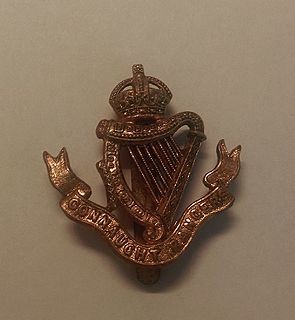 W
WThe Connaught Rangers were an Irish line infantry regiment of the British Army formed by the amalgamation of the 88th Regiment of Foot and the 94th Regiment of Foot in July 1881. Between the time of its formation and Irish independence, it was one of eight Irish regiments raised largely in Ireland. Its home depot was in Galway. It was disbanded following the establishment of the independent Irish Free State in 1922, along with the other five regiments that had their traditional recruiting grounds in the counties of the new state.
 W
WThe Conscription Crisis of 1918 stemmed from a move by the British government to impose conscription in Ireland in April 1918 during the First World War. Vigorous opposition was led by trade unions, Irish nationalist parties and Roman Catholic bishops and priests. A conscription law was passed but was never put in effect; no one in Ireland was drafted into the British Army. The proposal and backlash galvanised support for political parties which advocated Irish separatism and influenced events in the lead-up to the Irish War of Independence.
 W
WErected in 1927, the Diamond War Memorial is located on The Diamond in the centre of Derry, Northern Ireland. It is dedicated to the citizens of the city who lost their lives while in military service during World War I.
 W
WThe "Irish Brigade" was an attempt by Sir Roger Casement to form an Irish nationalist military unit during World War I among Irishmen who had served in the British Army and had become prisoners of war (POWs) in Germany. Casement sought to send a well-equipped and well-organized Irish unit to Ireland, to fight against Britain, in the aim of achieving independence for Ireland. Such an action was to be concurrent with the ongoing war between Britain and Germany, thereby providing indirect aid to the German cause, without the ex-POWs fighting in the Imperial Germany Army itself.
 W
WThe Irish National War Memorial Gardens is an Irish war memorial in Islandbridge, Dublin, dedicated "to the memory of the 49,400 Irish soldiers who gave their lives in the Great War, 1914–1918", out of over 300,000 Irishmen who served in all armies.
 W
WThe Island of Ireland Peace Park and its surrounding park, also called the Irish Peace Park or Irish Peace Tower in Messines, near Ypres in Flanders, Belgium, is a war memorial to the soldiers of the island of Ireland who died, were wounded or are missing from World War I, during Ireland's involvement in the conflict. The tower memorial is close to the site of the June 1917 battle of Messines Ridge, during which the 16th (Irish) Division fought alongside the 36th (Ulster) Division.
 W
WThe North Irish Horse is a yeomanry unit of the British Territorial Army raised in the northern counties of Ireland in the aftermath of the Second Boer War. Raised and patronised by the nobility from its inception to the present day, it was one of the first non-regular units to be deployed to France and the Low Countries with the British Expeditionary Force in 1914 during World War I and fought with distinction both as mounted troops and later as a cyclist regiment, achieving eighteen battle honours. The regiment was reduced to a single man in the inter war years and re-raised for World War II, when it achieved its greatest distinctions in the North African and Italian campaigns. Reduced again after the Cold War, the regiment's name still exists in B Squadron, the Scottish and North Irish Yeomanry and 40 Signal Squadron, part of 32 Signal Regiment.
 W
WThe Prince of Wales's Leinster Regiment was an infantry regiment of the line in the British Army, formed in 1881 by the amalgamation of the 100th Regiment of Foot and the 109th Regiment of Foot. The 100th Foot was first raised in 1858 and the 109th was first raised in 1853. Between the time of its formation and Irish independence, it was one of eight Irish regiments raised largely in Ireland, its home depot in Birr. It was disbanded with the Partition of Ireland following establishment of the independent Irish Free State in 1922 when the five regiments that had their traditional recruiting grounds in the counties of the new state were disbanded.
 W
WThe Royal Dublin Fusiliers was an Irish infantry Regiment of the British Army created in 1881, one of eight Irish regiments raised and garrisoned in Ireland, with its home depot in Naas. The Regiment was created by the amalgamation of two British Army regiments in India, the Royal Bombay Fusiliers and Royal Madras Fusiliers, with Dublin and Kildare militia units as part of the Childers Reforms that created larger regiments and linked them with "Regimental Districts". Both regular battalions of the Regiment fought in the Second Boer War. In the First World War, a further six battalions were raised and the regiment saw action on the Western Front, the Mediterranean, and the Middle East. In the course of the war three Victoria Cross were awarded.
 W
WThe Royal Inniskilling Fusiliers was an Irish line infantry regiment of the British Army in existence from 1881 until 1968. The regiment was formed in 1881 by the amalgamation of the 27th (Inniskilling) Regiment of Foot and the 108th Regiment of Foot.
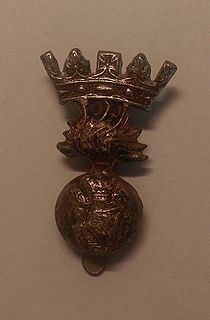 W
WThe Royal Irish Fusiliers was an Irish line infantry regiment of the British Army, formed by the amalgamation of the 87th Regiment of Foot and the 89th Regiment of Foot in 1881. The regiment's first title in 1881 was Princess Victoria's , changed in 1920 to the Royal Irish Fusiliers . Between the time of its formation and Irish independence, it was one of eight Irish regiments.
 W
WThe Royal Irish Regiment, until 1881 the 18th Regiment of Foot, was an infantry regiment of the line in the British Army, first raised in 1684. Also known as the 18th Regiment of Foot and the 18th Regiment of Foot, it was one of eight Irish regiments raised largely in Ireland, its home depot in Clonmel. It saw service for two and a half centuries before being disbanded with the Partition of Ireland following establishment of the independent Irish Free State in 1922 when the five regiments that had their traditional recruiting grounds in the counties of the new state were disbanded.
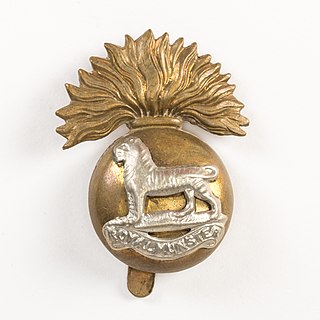 W
WThe Royal Munster Fusiliers was a line infantry regiment of the British Army from 1881 to 1922. It traced its origins to the East India Company's Bengal European Regiment raised in 1652, which later became the 101st Regiment of Foot. The Royal Munster Fusiliers were formed in 1881 by the merger of the 101st Regiment of Foot and the 104th Regiment of Foot. One of eight Irish regiments raised largely in Ireland, it had its home depot in Tralee and served as the county regiment for Cork, Clare, Limerick and Kerry. At its formation the regiment comprised two regular and two militia battalions.
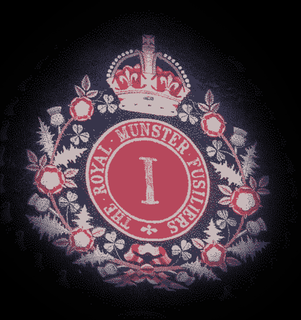 W
WThe Royal Munster Fusiliers was a regular infantry regiment of the British Army. One of eight Irish regiments raised largely in Ireland, its home depot in Tralee. With the outbreak of World War I in August 1914 the immediate need for a considerable expansion of the British Army resulted in the formation of the New Army under Lord Kitchener. The war target was seventy divisions in all, the New Army to have thirty volunteer divisions separate and under Army Order 324, as additional from the Regular Army, with a planned period of service of at least three years. On 7 August a general United Kingdom-wide call for 100,000 volunteers aged 19–30 was issued. The battalions were to be distinguished by the word 'Service' after their number.
 W
WThe Royal Irish Rifles was an infantry rifle regiment of the British Army, first created in 1881 by the amalgamation of the 83rd Regiment of Foot and the 86th Regiment of Foot. The regiment saw service in the Second Boer War, the First World War, the Second World War, and the Korean War.
 W
WThe South Irish Horse was a Special Reserve cavalry regiment of the British Army. Formed on 2 January 1902 as the South of Ireland Imperial Yeomanry. It was renamed as the South Irish Horse from 7 July 1908 and transferred to the Special Reserve (Cavalry). Having taken part in the fighting of the First World War, it was disbanded in 1922.
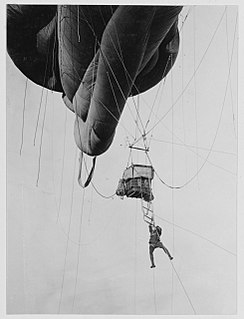 W
WU.S. Naval Air Station Berehaven was a Lighter-than-Air (LTA) kite balloon station at Berehaven, County Cork, Ireland that the United States Navy (USN) operated in the First World War. It was commissioned on 29 April 1918 and decommissioned on 12 February 1919.
 W
WU.S. Naval Air Station Lough Foyle was a seaplane station at Lough Foyle, Northern Ireland, which was operated by the United States Navy (USN) and commissioned on July 1, 1918 with Commander Henry D. Cooke, USN as the commanding officer.
 W
WUnited States Naval Air Station Queenstown was the first US Naval Air Station established in Ireland. NAS Queenstown was close to the village of Aghada on the eastern side of Cork Harbour. NAS Queenstown was commissioned on 22 February 1918 with LCDR Paul J. Peyton, USNRF, Naval Aviator 47 in command.
 W
WU.S. Naval Air Station Wexford was a seaplane station at Ferrybank, Wexford, Ireland which was operated by the United States Navy (USN) and commissioned on 2 May 1918. Its mission was to operate Curtiss H-16 anti-submarine patrols (ASW) to counter German submarine attacks on shipping in the area east of Queenstown. The Commanding Officer LCDR Victor D. Herbster reported on station on 28 March 1918.
 W
WU.S. Naval Air Station Whiddy Island was a US naval air station operated during the last year of World War I and commissioned 4 July 1918. Located on Whiddy Island in Bantry Bay, County Cork, Ireland, it was also known as Bantry Bay Station. The base was used for Anti-Submarine Warfare (ASW) patrols by Curtiss H-16 seaplanes.